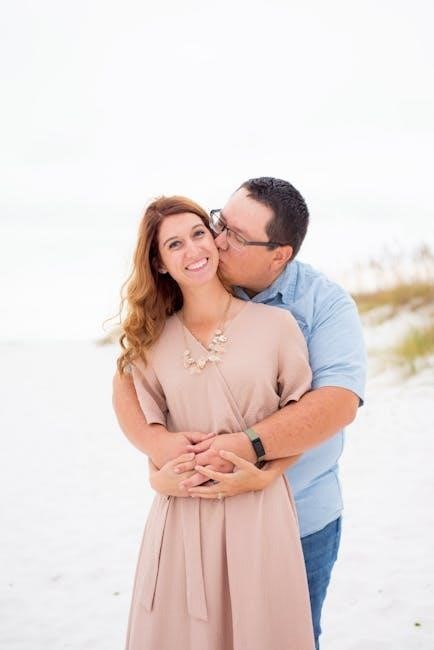Welcome to the ultimate guide for finding your perfect men’s dress shirt size. This comprehensive resource helps you understand measurements, styles, and troubleshooting for a flawless fit.
Importance of Proper Fit in Dress Shirts
A well-fitting dress shirt enhances confidence, professionalism, and comfort. Proper fit ensures the shirt lies smoothly across the chest, shoulders, and sleeves, avoiding unsightly wrinkles or constriction. A shirt that’s too tight can restrict movement, while one that’s too loose may appear sloppy. The right fit accentuates your physique, creating a polished look for any occasion. Measuring key areas like neck, chest, and sleeves ensures accuracy. Investing time in finding your ideal size guarantees both style and comfort, making it essential for a sharp, put-together appearance.
Understanding Key Measurements for Dress Shirts
Key measurements for dress shirts include neck, chest, and sleeve length. Neck size determines the collar fit, ensuring comfort and preventing tightness. Chest measurement ensures the shirt fits smoothly across the torso. Sleeve length impacts the overall look, with cuffs resting at the wrist. Accurate measurements ensure the right fit, avoiding both tightness and looseness. Proper sizing starts with these essential dimensions, ensuring a shirt that complements your body shape and personal style effectively.
Measuring for Your Dress Shirt Size
Measuring your neck, chest, and sleeve length accurately ensures the best fit. Use a tape measure and follow specific guidelines for precise results, ensuring comfort and style.
How to Measure Your Neck Size
To measure your neck size, place the tape measure around the base of your neck, just above the collarbone. Ensure the tape is snug but not tight, with room for one finger. Keep your head straight and shoulders relaxed for an accurate reading. This measurement corresponds to the shirt’s collar size, which is crucial for comfort and proper fit. Note: If measuring alone, take care to maintain a consistent position for reliable results.
How to Measure Your Chest Size
To measure your chest size, wrap a flexible tape measure around the widest part of your chest, typically just under your armpits. Stand straight and ensure the tape is level and snug, not tight or loose. This measurement helps determine the shirt’s comfort and fit. For accuracy, consider measuring directly on your skin or over a thin shirt. If measuring alone, keep the tape steady and avoid twisting. This ensures a precise fit, whether you prefer slim, regular, or relaxed styles.
How to Measure Your Sleeve Length
To measure your sleeve length, place the tape measure at the back of your neck, just below the base of the collar. Extend it down your arm, passing your shoulder, and stop at your wrist. Ensure your arm is slightly bent and relaxed. This measurement determines the shirt’s sleeve length, ensuring a proper fit. For accuracy, have someone assist you or use a shirt that fits well as a reference. This ensures the sleeves are neither too short nor too long, providing optimal comfort and style.

Using a Dress Shirt Size Chart
A dress shirt size chart helps determine your ideal fit by organizing sizes based on neck, chest, and sleeve measurements. Refer to it after measuring yourself accurately.
Interpreting Standard Size Charts
Standard size charts organize shirt sizes based on neck, chest, and sleeve measurements. They typically include numerical or alphabetical sizing, correlating measurements to fit styles. To interpret, match your measurements to the chart, ensuring accuracy for a perfect fit. Note that variations exist between brands, so refer to specific guides. Pay attention to sleeve length and chest circumference for optimal comfort. Double-checking your measurements ensures the best results when selecting your size from the chart.
Understanding Slim Fit vs. Regular Fit
Slim fit shirts are tailored closer to the body, offering a modern, streamlined appearance. Regular fit shirts provide a classic, comfortable cut with more room across the chest and shoulders. Slim fit suits leaner builds or those preferring a contemporary style, while regular fit accommodates broader frames or offers ease of movement. Consider your body type, lifestyle, and personal preference when choosing between these styles for the best comfort and aesthetic appeal. Proper fit ensures both functionality and confidence.
How to Choose the Right Size Based on Measurements
Start by accurately measuring your neck, chest, and sleeve length using a flexible tape measure. Record these measurements and compare them to a standard size chart. Ensure your neck size aligns with the collar circumference, and your chest measurement matches the shirt’s chest width. Sleeve length should reach the base of your thumb when arms are relaxed. Avoid sizing up or down unless necessary, as this can lead to an ill-fitting shirt. Proper alignment of all three measurements guarantees the best fit for comfort and style.
Common Fit Problems and Solutions
Address issues like tight collars, baggy chests, or mismatched sleeves. Adjust measurements, opt for slim or relaxed fits, and consider alterations for a tailored, comfortable look.
Issues with Neck Size and How to Fix Them
A poorly fitting collar can ruin the comfort and appearance of a dress shirt. If the collar is too tight, it can restrict movement and cause discomfort. Conversely, a collar that’s too loose may look unprofessional. To address this, ensure accurate neck measurements and choose a shirt with adjustable cuffs for flexibility. Opting for a slim or classic fit based on your body type can also resolve neck size issues. If the problem persists, consider alterations to achieve the perfect fit.
Common Chest Fit Problems and Solutions
A common issue with dress shirts is improper chest fit. A shirt that’s too tight can restrict movement and create an unflattering silhouette, while one that’s too loose may look sloppy. To resolve this, ensure accurate chest measurements and compare them to a size chart. Choose a shirt that allows a full range of motion without excess fabric. If needed, opt for alterations like darts or adjustments to achieve a balanced, polished look that combines comfort and style.
Addressing Sleeve Length Issues
Sleeve length is a critical factor in achieving the perfect fit. If sleeves are too short, they may not cover your wrists properly, while overly long sleeves can look disproportionate. To address this, ensure accurate arm measurements and consult a size chart. Consider tailored alterations if necessary. Proper sleeve length enhances both comfort and aesthetics, ensuring your dress shirt looks polished and well-fitted. Pay attention to how cuffs sit on your wrists for a balanced, professional appearance that complements your overall style.
Dress Shirt Fit Styles
Dress shirts come in various fit styles, including slim, regular, and relaxed, each catering to different body types and personal preferences for a tailored look.
Understanding Different Fit Types (Slim, Regular, Relaxed)
Dress shirts are available in slim, regular, and relaxed fits. Slim-fit shirts hug the body closely, ideal for a modern, tailored look. Regular-fit shirts offer a classic, slightly roomier silhouette, while relaxed-fit shirts provide maximum comfort with a looser cut. Each style caters to different body types and preferences, ensuring a flattering appearance. Understanding these options helps men choose the best fit for their physique and desired aesthetic.
How to Determine the Best Fit for Your Body Type
Choosing the right fit involves understanding your body type. Slim-fit shirts suit lean builds, while regular or relaxed fits are better for broader frames. Measure your neck, chest, and sleeves to align with size charts. Consider fabric drape and style to ensure comfort and aesthetics. For muscular builds, opt for slightly roomier cuts to avoid tightness. Larger body types may prefer relaxed fits for ease of movement. Balance fit with personal comfort to achieve a polished, confident look tailored to your physique.
Factors Influencing Fit (Fabric, Cut, and Style)
Fabric, cut, and style significantly impact how a dress shirt fits. Heavier fabrics provide structure, while lighter materials drape softly. Slim-fit shirts contour closely to the body, while relaxed cuts offer more comfort. Style elements like collar height and cuff design also affect overall fit. Consider your body type and personal comfort when selecting fabric weight and cut. Ensure the shirt moves naturally with you, balancing style and functionality for a polished appearance tailored to your preferences and lifestyle.

Collar and Cuff Styles
Collar and cuff styles enhance both functionality and aesthetics. From pointed to spread collars, and barrel to French cuffs, these details define the shirt’s formality and personal flair.
Popular Collar Types and Their Suitability
Popular collar types include the classic Oxford, versatile spread, and elegant wingtip. The Oxford collar suits casual and formal settings, while the spread collar pairs well with wide tie knots. The wingtip collar is ideal for formal events like black-tie occasions. Each style complements different face shapes and body types, ensuring a tailored look. Understanding collar types helps in selecting a shirt that enhances your overall appearance and matches your personal or professional preferences effectively.
Choosing the Right Cuff Style for Your Needs
Men’s dress shirts feature various cuff styles, each suited for different occasions; Barrel cuffs are the most common, offering a classic look and ease of use. French cuffs, also known as double cuffs, are ideal for formal events, requiring cufflinks for a sophisticated finish. Button cuffs provide a sleek, minimalist appearance, perfect for business casual settings. Consider your lifestyle and the formality of the event to select the cuff style that best complements your wardrobe and personal aesthetic.
How Collar and Cuff Styles Affect Fit
Collar and cuff styles significantly influence the overall fit and appearance of a dress shirt. A spread collar provides a broader frame, complementing wider faces, while a pointed collar suits narrower features. Cuff styles, such as French or barrel, affect sleeve proportions. Ensuring the collar fits snugly without constriction and the cuffs align with your wrist size enhances comfort and aesthetics. Balancing these elements ensures a tailored look that flatters your body type and personal style.

Fabric and Color Considerations
Fabric and color choices significantly impact both comfort and style. Lighter fabrics like cotton breathe well, while darker colors slim the silhouette. Choose hues that complement your skin tone for a polished look.
How Fabric Weight and Material Affect Fit
Fabric weight and material play a crucial role in how a dress shirt fits and feels. Heavier fabrics like twill or canvas provide structure and drape, while lighter fabrics such as voile or linen offer a softer, more relaxed fit. Thicker materials may require a slightly roomier cut to ensure comfort, whereas lightweight fabrics can skim the body for a sleek look. Natural fibers like cotton breathe well, while synthetic blends may offer stretch for added mobility, enhancing overall comfort and fit.
Choosing Colors That Complement Your Skin Tone
Selecting colors that flatter your skin tone enhances your appearance. Cool tones look best in whites, light blues, and purples, while warm tones suit earthy shades like olive and terracotta. Neutral tones like light pink and charcoal work for most skin types. Bright colors can make a statement, but softer hues create a more subtle, polished look. Consider your skin undertones to find shirts that make you look vibrant and confident, ensuring a harmonious balance between color and complexion;
Patterns and How They Impact the Overall Look
Patterns can elevate or distract from your overall appearance. Stripes create a slimming effect, while checks add a rugged touch. Solid colors offer versatility, pairing effortlessly with any outfit. Subtle textures like pinpoint or twill add depth without overwhelming. Bold patterns draw attention, so balance them with simpler pieces. Consider your body type: vertical stripes elongate torsos, while horizontal stripes can broaden shoulders. Choose patterns that complement your fit style and personal aesthetic for a polished, cohesive look that enhances your confidence and sophistication.

Troubleshooting Common Sizing Issues
If your shirt fits poorly, check measurements for accuracy. Address tightness or looseness by adjusting sizes. Sleeve length and collar fit can often be resolved with alterations or re-measuring.
What to Do If Your Shirt Is Too Tight or Too Loose
If your shirt feels too tight, check your measurements for accuracy. Consider altering the shirt or consulting a tailor for adjustments. For a shirt that’s too loose, try sizing down or opting for a slim-fit style. Ensure proper fit by addressing specific areas like sleeve length or collar tightness. Accurate measurements are key to avoiding sizing issues. If adjustments aren’t possible, explore alterations or re-measuring to find the perfect fit for comfort and confidence.
Adjusting Sleeve Length for a Better Fit
Adjusting sleeve length is crucial for achieving the perfect fit in a men’s dress shirt. Sleeves that are too long can make the shirt appear baggy, while sleeves that are too short may look ill-fitting. The standard measurement for sleeve length is from the center back of the neck, over the shoulder, and down to the wrist. This measurement ensures the sleeve reaches the desired length for both comfort and style. For formal occasions, sleeves should extend slightly beyond the jacket cuffs, while casual settings may allow for shorter lengths. Fabric thickness can influence sleeve length—thicker fabrics might require longer sleeves for balance, whereas thinner fabrics can work well with shorter sleeves. If a shirt has sleeves that are too long or short, alterations or DIY adjustments can be made, though professional tailoring is often the best approach. Cultural and personal preferences also play a role, with some styles favoring longer sleeves for a more traditional look; Ensuring that sleeve length complements other measurements, like chest and neck size, is essential for a polished appearance. Tools and online guides are available to help with adjustments, but consulting a tailor can provide the most precise results. By considering these factors, one can achieve sleeves that enhance both comfort and aesthetics, making the shirt look tailored to perfection.
Resolving Discrepancies Between Size Charts
Different brands often have varying size charts, leading to discrepancies in fit. To resolve this, compare your measurements across multiple guides and read customer reviews to gauge sizing accuracy. If a shirt fits well in one brand but not another, note the differences in chest, neck, and sleeve measurements. Consider alterations for minor adjustments or opt for brands with consistent sizing. Using universal sizing standards can also help bridge gaps between charts, ensuring a more reliable fit across different brands and styles.

Maintenance and Care Tips
Wash dress shirts in cold water to prevent shrinkage and fading. Use gentle detergents and avoid fabric softeners. Iron while slightly damp for crisp results, always inside out.
How to Wash and Iron Your Dress Shirt for Longevity
Washing your dress shirt in cold water prevents shrinkage and fading. Use a mild detergent and avoid fabric softeners, as they can damage the fabric. Iron your shirt while it’s slightly damp, starting with the collar and working your way down. Always iron inside out to prevent sheen on the fabric. Avoid over-drying, as it can cause shrinkage. Proper care ensures your dress shirt remains crisp and well-fitting for years to come.
Storing Your Dress Shirts to Maintain Shape
To keep your dress shirts looking their best, use sturdy, padded hangers to support their structure and prevent stretching. Always button the shirt completely before hanging to maintain alignment and reduce wrinkles. Store shirts in a cool, dry place with consistent humidity to avoid mildew or fabric degradation. Consider using breathable garment bags instead of plastic covers to protect against dust and moisture. Ensure your closet isn’t overcrowded, as this can cause creasing or misshaping.
When to Consider Alterations for a Perfect Fit
If your dress shirt doesn’t fit perfectly off the rack, consider professional alterations to achieve a tailored look. Common adjustments include shortening or lengthening sleeves, tightening or loosening the collar, and slimming the torso for a more streamlined fit. Minor tweaks, like adjusting button placement or darts, can also enhance comfort and appearance. Alterations are especially worthwhile for high-quality shirts, ensuring they flatter your body and meet your personal style preferences for years to come.

Frequently Asked Questions
- How do I measure my neck for the perfect fit?
- What if my shirt is too tight or too loose?
- How do I adjust sleeve length for accuracy?
- Why do size charts vary between brands?
Common Questions About Dress Shirt Sizing
- How do I accurately measure my neck, chest, and sleeve length for the best fit?
- Why do dress shirt sizes vary between brands and styles?
- What is the difference between slim-fit, regular-fit, and relaxed-fit shirts?
- How can I determine if a shirt is too tight or too loose?
- Can I alter a shirt if it doesn’t fit perfectly?
Addressing Myths About Dress Shirt Fit
Many myths surround dress shirt fit, such as believing all shirts fit the same or that looser shirts are more comfortable. In reality, proper fit enhances both comfort and appearance. Another myth is that cuff style doesn’t matter, but it impacts both functionality and aesthetics. Understanding these misconceptions helps in making informed choices for a tailored look.
Where to Find Reliable Sizing Guides Online
Reputable sizing guides can be found on official brand websites, such as Brooks Brothers or Nordstrom, which offer detailed measurement charts. Additionally, websites like Men’s Health and Esquire provide comprehensive guides tailored to different body types. Use search terms like “dress shirt size chart” to locate reliable resources. Third-party sizing tools and forums also offer insights, ensuring a well-fitted shirt every time.
Finding the perfect dress shirt fit requires precise measurements and a focus on quality. Invest in a well-tailored shirt to elevate your style and confidence.
Final Tips for Finding Your Perfect Dress Shirt Size
Accurate measurements are key to a great fit. Consider your body type and lifestyle when choosing between slim, regular, or relaxed styles. Fabric and color should complement your skin tone and personal style. Always refer to a sizing chart, and don’t hesitate to seek alterations for perfection. Quality and comfort go hand in hand, ensuring confidence and elegance in every outfit.
Importance of Investing in Quality and Fit
A well-fitted dress shirt enhances confidence and creates a polished appearance. Investing in quality ensures durability and comfort, while proper fit guarantees a flattering silhouette. Quality fabrics and construction provide longevity, while a tailored fit ensures the shirt moves naturally with your body. Prioritizing both quality and fit elevates your style, making every outfit look intentional and sophisticated. A perfect fit is not just about measurements—it’s about how the shirt makes you feel.
